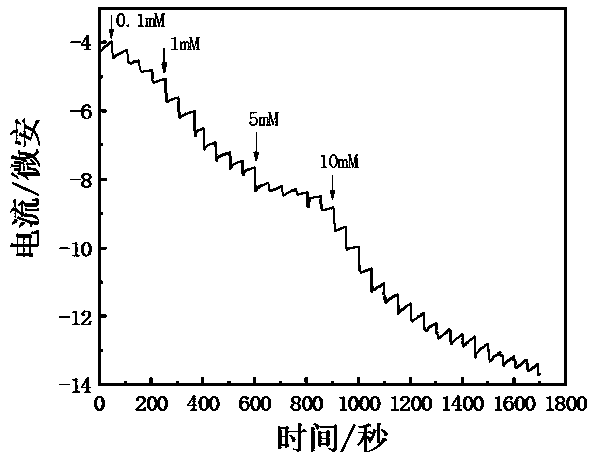Preparation method and application of rod-like nickel disulfide-molybdenum disulfide nano-composite
A nanocomposite, nickel disulfide technology, applied in the direction of nickel sulfide, molybdenum sulfide, material electrochemical variables, etc., can solve the problems of small specific surface area, low activity of nickel disulfide, etc., to achieve simple synthesis, low cost, excellent subsurface The effect of nitrate on the properties
- Summary
- Abstract
- Description
- Claims
- Application Information
AI Technical Summary
Problems solved by technology
Method used
Image
Examples
Embodiment 1
[0047] (1), respectively weigh 1.5 grams of nickel nitrate hexahydrate and 1.5 grams of sodium thiosulfate pentahydrate in deionized water, and stir for 5 minutes;
[0048] (2), take by weighing 30mg cetyl trimethyl ammonium bromide and add in the mixed solution obtained in step (1) and stir for 10 minutes;
[0049] (3) Add 8ml of ethylenediamine to the mixed solution obtained in step (2), stir evenly, transfer it to a high-pressure reaction kettle, and react at 160°C for 20h;
[0050] (4) After centrifuging the reaction product in step (3) to remove water, first wash with ethanol to remove unreacted organic matter, then wash with deionized water to remove unreacted inorganic ions, and place the washed reaction product in a Dry in an oven at 70°C;
[0051] (5), placing the product obtained in step (4) in a tube furnace, passing argon gas, and calcining at 300 ° C for 2 hours to obtain nickel disulfide;
[0052] (6), respectively weigh 130mg ammonium tetrathiomolybdate and 60...
Embodiment 2
[0061] The three-electrode system prepared in Example 1 was placed in a solution containing no and 1, 2, and 4 mmol dm -3 0.1mol dm of sodium nitrite -3 The catalytic performance of rod-shaped nickel disulfide-molybdenum disulfide complexes for nitrite was determined by cyclic voltammetry in phosphate buffer solution. The cyclic voltammogram is shown in figure 2 shown.
[0062] figure 2 Modified glassy carbon electrodes for rod-shaped nickel disulfide-molybdenum disulfide composites without and with 1, 2, and 4 mmoldm -3 0.1 mol dm of sodium nitrite -3 Cyclic voltammogram in phosphate buffered solution. It can be seen from the figure that when the composite modified glassy carbon electrode was moved from the phosphate buffer solution to the solution containing sodium nitrite, an oxidation peak appeared near 0.3 V, and the peak appeared with the increase of nitrite concentration. the current increases. This result indicates that nitrite undergoes a reduction reaction at...
Embodiment 3
[0065] The three-electrode system prepared in Example 1 was placed in 0.1 mol dm -3 In the phosphate buffer solution, sodium nitrite solutions of different concentrations were added dropwise, and the response current values corresponding to different concentrations of sodium nitrite solutions were measured by potentiostatic method, and the linear relationship between the concentration of nitrite and the response current was obtained ( image 3 );
[0066] from image 3 It can be seen from: rod-shaped nickel disulfide-molybdenum disulfide composite modified glassy carbon electrode for 0.1 mmol dm -3 nitrite can respond. Figure 4 is true image 3 A plot of nitrite concentration versus response current. As can be seen from the graph: at 8 to 4300µmol dm -3 A good linear relationship is maintained within the range of .
PUM
 Login to View More
Login to View More Abstract
Description
Claims
Application Information
 Login to View More
Login to View More - R&D Engineer
- R&D Manager
- IP Professional
- Industry Leading Data Capabilities
- Powerful AI technology
- Patent DNA Extraction
Browse by: Latest US Patents, China's latest patents, Technical Efficacy Thesaurus, Application Domain, Technology Topic, Popular Technical Reports.
© 2024 PatSnap. All rights reserved.Legal|Privacy policy|Modern Slavery Act Transparency Statement|Sitemap|About US| Contact US: help@patsnap.com










